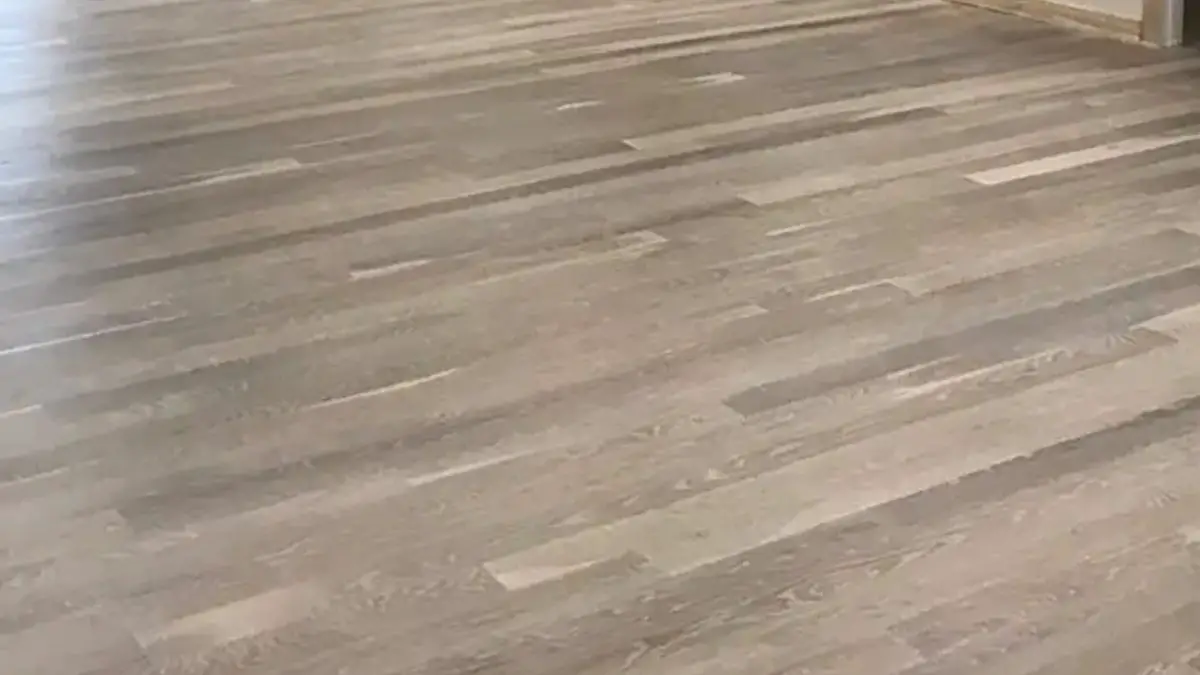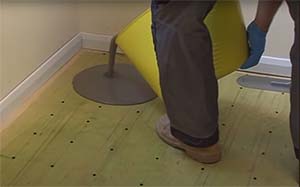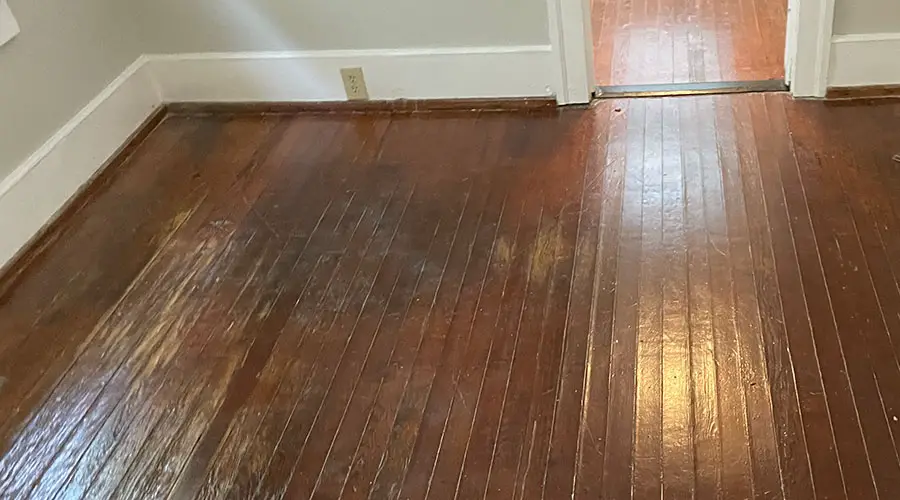
When looking for a warm and natural flooring, hardwood floors tops my list because it blends well with any décor and the varieties make it possible for us to accomplish a robust look. However, hardwood floors are always accompanied by problems such as buckling and crowning due to moisture, which makes us question the cause of it?
Moisture under hardwood floors is often caused by four factors: water on or under the floor, high humidity, poor installation, or no acclimation. Wood is hygroscopic and vulnerable to moisture, leading the boards to peel away from the subfloor and can cause discoloring on the hardwood floor.
Hardwood flooring is unique on its own, but it requires maintenance. Without proper preparation and care before installation, it will become distorted in ways that could adversely affect its long-term beauty.
Moisture Level for Your Hardwood Floors
Hardwood flooring is durable and practical, especially for interior applications. Aside from residential houses, businesses often choose this type of flooring in their office for a more sophisticated and elegant atmosphere.
Many business owners and homeowners don’t know that hardwood floors can easily be ruined by moisture. Swelling and cupping is the effect of too much water, while too little humidity can cause these flooring to crack and wither. The question now is, what would be the safest level of moisture in hardwood floors?
Your living environment can affect the performance of your floor. During the warm summer months, humidity levels are very high. In contrast, cold winter months with the heating on reduce humidity, causing the flooring to shrink. All year round, you should maintain a humidity level between 35 – 55%.
Air conditioning can help with high humidity along with a dehumidifier if it’s not sufficient. A humidifier or a steam humidification system for larger homes can help in controlling low humidity.
I recommend that homeowners with hardwood flooring purchase an inexpensive moisture meter. A good moisture meter that won’t damage your hardwood is the Klein Tools Pinless Moisture Meter available at Amazon. I have owned this moisture meter for well over a year and use it daily.
No Acclimation and Poor Installation Can Affect Hardwood Floor Durability
Woods are hygroscopic, which means that it absorbs moisture from the environment it is in. This material is why proper acclimation is a necessary step to the installation process of hardwood floors, and it begins with proper storage on the job site.
Even with engineered flooring, manufacturers suggest that to retain warranty, maintaining that 35 – 55% relative humidity on the job site is essential even after the installation. To achieve proper acclimation, cross-stacking and encouraging air circulation on the wood floors is the best way to do it.
Failing the process of acclimation will show signs of hardwood floor distortion, and it can be disappointing. So, it is best not to rush the installation process and spend time going through the vital steps instead of dealing with negative consequences later.
Another cause of moisture under your hardwood floors is poor installation. For instance, the floors are installed with insufficient fasteners or wrong-sized fasteners or no adequate expansion gaps around the floor’s perimeter. These mistakes can cause the floor to have cracks and buckles.
Having wet subfloors when the floorboards are installed is another installation mistake that allowed the floor to absorb too much moisture. Concrete subfloors should have a vapor barrier installed underneath.
Early Warning Indications of Moisture in Flooring
Spotting moisture problems early on will help to minimize the damage they can cause. So what are these early warning signs that tell you there are moisture problems in your wood floors?
If you see consistent water droplets forming on the surface of your wood floor without a clear source, it’s a sign that there is excess moisture in the floorboards. High relative humidity (RH) causes condensation on surfaces.
Moisture promotes bacteria and rusting in wood, which can give off a strong scent or stale odors. This kind of scent might serve as an indication of a moisture intrusion problem. Discoloration of flooring is another sign that moisture is present on the wood. If you notice any mismatched looks on the finish of your floorboards compared to others, then water has probably intruded.
Pests, such as termites, thrive in woods with excessive moisture, so if there is a sudden invasion of these pests, it could indicate that your wood floors have too much water.
Note that these are indirect indications of moisture on your hardwood floors, and it is still advised to get a quantitative measurement of the moisture content to be sure.
5 Obvious Signs of Moisture Under Hardwood Floors
Wood flooring problems that are moisture-related are visible to the sharp eye. If you are still unsure if it’s the case with your flooring, here are the warning signs you should look out for:
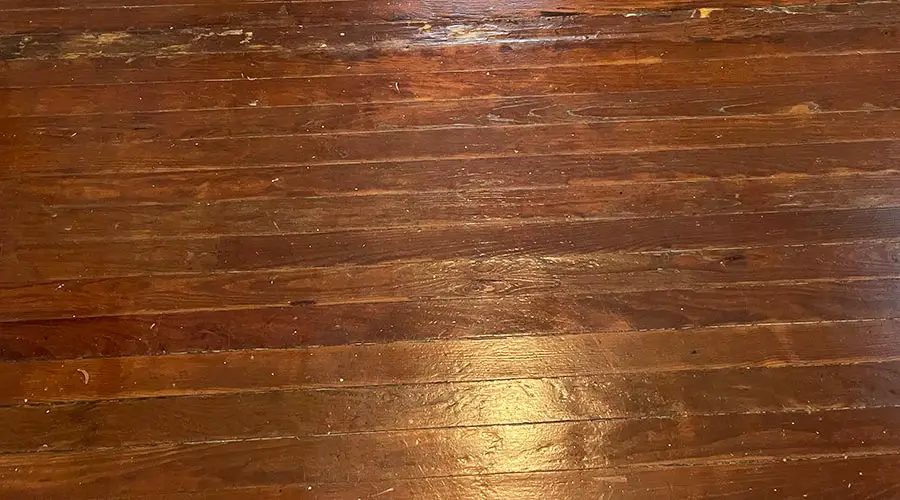
1. Cracks and Gaps Between Boards
When homes are heated during the winter season, the RH level can drop, causing spaces to appear in between the boards or planks. Some variations of wood floors are seasonal and will close up when the weather changes and the moisture content increases.
Cracks and gaps can cause accidents and should be monitored, especially if the weather shifts. Old hardwood floors will develop holes that are more or less permanent. When the floorboards are tightest during the humid season, check if you find gaps large enough that nickel can slide into it because you need to fix it.
2. Crowning of the Boards
Crowning happens when the unfinished surface of the flooring boards is exposed to moisture before finishing. When the floor is crowning, the edges are sloped downward while the middle is raised or arched. Another cause of crowning is the floor was sanded before the moisture content reverts to its normal state.
When there are signs of crowning, the moisture content on the top is higher than the bottom where the subfloor is. Once the woods absorb the moisture, it reacts by swelling. This problem happens during the warmer months, but it doesn’t only occur from the moisture content in the air. Many factors can contribute to hardwood crowning. Some examples are:
- Mopping of your wood floors
- Areas where wet shoes come in direct contact with the wood.
- Appliances that have a water-line and causes leaking (e.g., dishwashers and refrigerators)
- Areas where you place your pet’s water bowls.
All of these examples will cause crowning and further damage to your floors, but it can be prevented by not letting water sit on your floors for too long.
3. Cupping of the Boards
High RH is usually the culprit of cupping on wooden floors, but it also means that water or water vapor is emanating below the floorboards. Cupping is the first sign of a moisture problem on your hardwood floors, and you’ll know it when each plank has a hollow appearance.
What happened is that the bottom side of your floorboards was absorbing more moisture than the top area. A broken pipe can be the cause of it or the excess humidity brought by insufficiently insulated crawlspace.
Once you notice cupping on your wood floors, the next step is to identify the direct cause and addressed it. Remember that when wood floors are cupped, it’s telling you that there is a moisture level disparity between the top and the bottom, so if you don’t do anything, it will just keep on happening, ultimately leading the floors to buckle and get damaged.
Cupping can happen even if the floors are correctly installed. It all depends on the environment and the conditions of the building or area you are located. But, wood floor cupping is expected that it can be reversed and fixed most of the time.
4. Hardwood Flooring is Buckling
Like other signs discussed above, buckling of solid wood floors, engineered wood, or laminated wood floors is caused by excessive moisture. Buckling is the opposite of cupping, as it forms peaks and grooves and bends the other way. You’ll know when the floor gets detached from the subfloor.
Buckling is what you get when you expose hardwood floors to water or moisture for an extended period. This problem also arises after flooding, subfloor moisture buildup, leaking pipes, and drainage issues. Also, it is often accompanied by cupping.
Adding weight to the floor until the moisture dries out is a simple solution to wood floor buckling, but if the problem is more serious, you may have to remove the floorboards to allow air circulation and dry out the moisture. If excess moisture is not the cause, then it’s probably poor installation.
You can repair hardwood floors buckling once you’ll know the cause and eliminate it. Restoring it is relatively easy, but it should be fixed at the first sign to avoid significant repairs and damage further later on.
5. Hardwood Floor is Squeaking
The dry winter heat and heater inside your home will cause your wood floor to contract and squeak. The contractions allow more room for your floorboards to move, making the planks rub against each other. Note that seasonal squeaks are common and go back to normal once the temperature is balance.
Aside from moisture, another cause of squeaking is the joists beneath your floor and subfloor. These bars help stabilize your subfloor and prevent any movement from happening, which means that any issues (like a sagging floor joist) will result in loose flooring, creating that squeaking noise.
The problem might be from the subfloor if squeaking is not caused by either moisture or joist. It can be the uneven subfloors that create a space from the top floor. Subfloors that are old and have suffered water damage would also result in your floorboards squeaking.
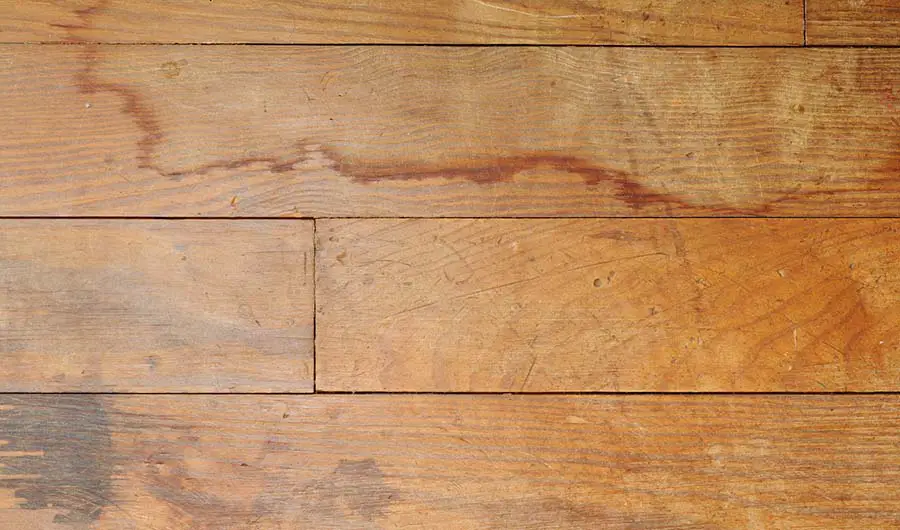
Saving Your Hardwood Floors from Water Damage
To save your wood floors, remove the water quickly and dry them properly. The key is speed, and it’s critical not to let your wood sit with any form of moisture for long because the damage can worsen. You will most likely have to sand and refinish the woods, but it will prevent you from the hassle and cost of replacing the hardwood.
If you’re dealing with the aftermath of a flood or a significant plumbing accident, then you can take these steps to prevent permanent damage to your flooring:
- Remove water-soaked items from the floor. The things include rugs and furniture drenched with water and will continue to drip more moisture into the wood. Wet furnishings can grow mold that can get into the core of your flooring. Remove and place them in an area where they can dry without damaging the floor.
- Mop or absorb as much of the water as possible. Take out all your mops, towels, and clean rags to immediately soak up small puddles. But for a more significant amount of water coming out from your flooring, it’s best to use a wet vacuum until you don’t see any water in the vacuum canister.
- Inspect for mold. Molds are a health hazard inside residences or commercial spaces, and anyone can experience allergic reactions or breathing problems once they come in contact with it.
When the flooring looks visibly dry, check for molds around the spores and scrub it with a baking soda and water solution before soaking up the moisture with a wet vacuum until it is thoroughly dried.
- Conduct a moisture test. Use a moisture testing meter to check for any remaining moisture in the wood. It can take several weeks for wood floorings to completely dry, and factor that in with the amount of humidity in the room. So leave your dehumidifier running until the testing meter shows no sign of water remaining in the wood.
One of the most important things to keep in mind when dealing with flooded hardwood floors is never to wait for them to dry naturally. The sooner you take the steps mentioned, the better your flooring’s condition will be. Letting the water sit on the floors will end up shortening your hardwood floor’s lifespan.
When to Call Professionals to Tackle Your Hardwood Floor Issues
Beyond the minor scratches or minor incidents that require hardwood floor repair, the more significant damage should be left to the professionals.
If the floor is installed poorly and you’ll start to notice buckling, you will need help adjusting it not just from anyone but to someone who has knowledge on fixing this type of issue and knows how to prevent it in the future.
If you’re experiencing repeated water exposure, it can penetrate through the stains and wood grains, causing it to swell and warp, requiring your to replace the wood. As the flooring ages, it’s also prone to crack, and even a tiny split can widen over time.
Experts in hardwood floors have the experience to tackle a variety of issues associated with it. You can prevent some problems if professionals handle them, so it’s best to call them and let them do the job, whether it is a minor or significant fix.
Conclusion
Hardwood floors are beautiful, giving your home a luxurious look. Still, you have to keep in mind that wood flooring entails a certain amount of maintenance to prevent any unwanted damages.
If you have a new home or office area where you want to install hardwood floors, it’s best to be confident that your location is perfect for these types of flooring, as it can be a disaster in the long run. Remember that moisture or water is the enemy of hardwood floors, and if your location is prone to flood, it is recommended not to use it.
This is worth mentioning because not all homes or buildings are suitable for retaining the wood floor quality after installation. It is ideal for getting an evaluation and adequately assess the property before purchasing your hardwood floor.
Take note that if you notice cupping, crowning, buckling, or squeaking on your hardwood floors, then there’s probably an imbalance in terms of the moisture content in the area. It’s essential to understand how to prevent these issues and take the necessary actions to avoid damaging your hardwood floors further.




